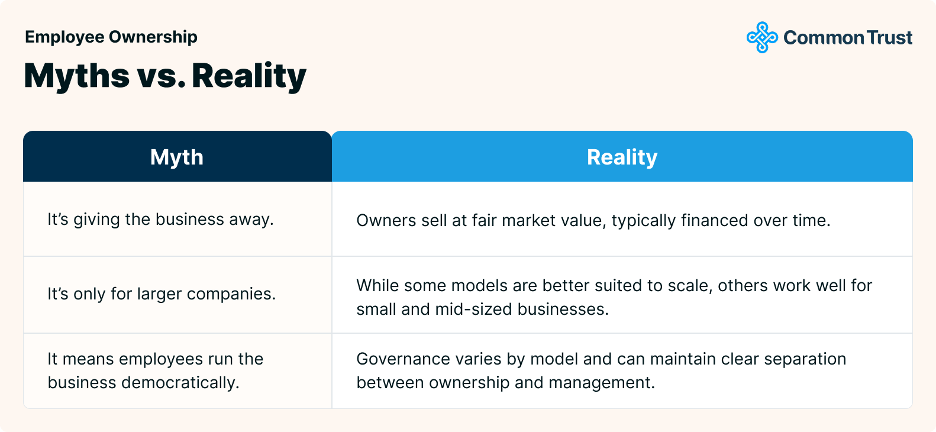Employee Ownership: A Modern Path to Preserve Your Legacy
A modern succession path for values-driven owners.
The best exits do more than cash you out —they carry your legacy forward. But finding a values-aligned buyer is harderthan it sounds. Strategic buyers might not preserve your culture. Private equity often brings a different set of priorities. And family succession isn’t always feasible.
There’s another option, one that’s quietly gaining traction across industries from manufacturing to services to software: selling your business to your employees.
The hidden cost of selling your business
We’re in the midst of a major generational shift. In the coming decade, millions of small and mid-sized businesses will be seeking new leadership as owners look toward retirement. Yet research shows that 75% of business owners regret their exit within a year[1].
While the financial return may be strong, the post-sale reality often tells a different story:
● The company’s mission drifts from its original purpose
● Jobs become consolidated, outsourced, or eliminated entirely
● Product or service quality declines
● The culture that defined the business begins to erode
Employee ownership flips the script.
Instead of selling to an outside buyer, founders can sell internally to their teams — exiting on their terms, receiving fair market value, and keeping the mission, jobs, and community impact intact.
Why more founders are choosing employee ownership
For legacy-minded owners, selling to employees isn’t just an altruistic choice. It’s a proven way to align financial returns with cultural and community outcomes:
● 50% lower bankruptcy rates[2]
● 33% higher employee wages[3]
● 93% higher employee net wealth[3]
These outcomes appeal both to retiring founders seeking a values-aligned handoff and to entrepreneurs who want to step back from daily operations while ensuring the business remains resilient.
What employee ownership is not
Despite growing interest, there are still a few myths around employee ownership:

Employee ownership models: EOTs, ESOPs & Worker Co-ops
Employee ownership typically refers to broad-based models — where ownership is shared widely among employees, not concentrated in a small group. The most common examples are:
Employee Ownership Trust (EOT)
An EOT is a type of Perpetual Purpose Trust(PPT) designed to benefit employees collectively. Unlike a trust created for a single beneficiary, an EOT’s stated purpose is to serve the collective workforce.
Key characteristics of an EOT:
● The owner sells shares to a trust that holds the company for the benefit of employees
● Employees share in profits and often have a greater voice in governance
● No personal buy-in required from employees
● When employees leave, they exit without triggering costly repurchase obligations
EOTs are not regulated like ESOPs, offering more flexibility around participation rules, profit distribution, and cultural preservation. They work well for companies seeking stable, long-term ownership, though they may not be ideal for those with concentrated ownership or professional license requirements (e.g., medical, legal, tax).
Employee Stock Ownership Plan (ESOP)
An ESOP is a regulated retirement benefit in which employees accumulate shares over time. Governed under ERISA by theDepartment of Labor, they have defined eligibility rules and compliance requirements. ESOPs can offer tax advantages and are often suited to larger companies with the administrative capacity to manage them.
Worker Cooperatives (Co-Ops)
In a Co-op, the business is owned and democratically governed by its employees. This structure fosters deep engagement and equitable wealth-building, but requires a culture of participation and alignment to succeed.
Blending ownership models for your ideal outcome
While broad-based models extend ownership to all employees, some companies combine them with direct ownership — where asmaller, defined group (such as key leaders or family members) holds shares directly — to strengthen leadership continuity while still achieving the benefits of employee ownership.
A Management Buyout (MBO) is one type of direct ownership, in which ownership transfers to a small group of trustedleaders already running the business. MBOs can:
● Provide leadership stability during transition
● Incentivize long-tenured executives to stay
● Work alongside broad-based ownership structures like an EOT or ESOP
In the case of an MBO, many business owners pair a more traditional leadership transfer with a broad-based model to unlock the performance gains of employee ownership. This approach combines leadership continuity with meaningful participation across the workforce.
For example, a company might:
● Establish a pool of broad-based ownership through an EOT (or similar structure)
● Provide direct share ownership fora select group of key leaders
Finding the right blend preserves the company’s mission, maintains operational stability, and extends ownership benefits to the wider team. It can also offer a competitive leadership package— similar to what private equity provides — without sacrificing cultural and community values.
Dive deeper into employee ownership
A traditional sale might be the default exit —but it’s not the only one. If you’re exploring your exit strategy, employee ownership is worth a closer look.
Curious about what employee ownership could look like for your company?
Learn more at www.common-trust.com.
.png)






